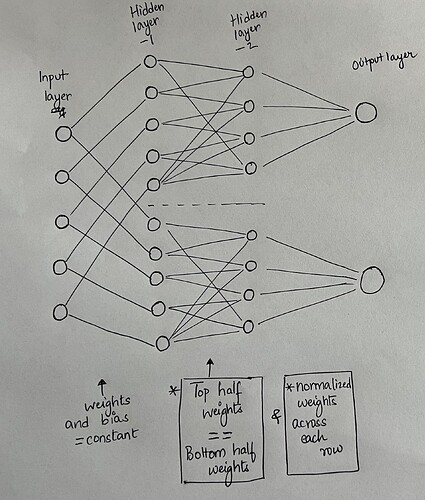class Net(nn.Module):
def __init__(self, input_size, hidden_1_size, hidden_2_size, output_size, mask_one, mask_two):
super(Net, self).__init__()
self.fc1 = nn.Linear(input_size, hidden_1_size, bias=True)
self.fc2 = nn.Linear(hidden_1_size, hidden_2_size)
self.fc3 = nn.Linear(hidden_2_size, output_size)
final_layer_weights = torch.ones(size=(1,hidden_2_size), requires_grad=False) * (1/hidden_2_size)
with torch.no_grad():
self.fc1.weight.mul_(mask_one)
self.fc2.weight.mul_(mask_two)
self.fc3.weight = nn.Parameter(final_layer_weights)
def forward(self, x):
x = self.fc1(x)
x = self.fc2(x)
x = self.fc3(x)
return x
# Parameters
n_inputs = 5
n_hidden_1 = 5
n_hidden_2 = 4
n_output = 1 # OUTPUT
mask1 = torch.tensor([[1,0,0,0,0],[0,1,0,0,0],[0,0,1,0,0],[0,0,0,1,0],[0,0,0,0,1]])
mask2 = torch.tensor([[1,1,0,0,1],[0,1,1,0,1],[0,0,1,1,1],[1,0,0,1,1]])
model = Net(n_inputs, n_hidden_1, n_hidden_2, n_output, mask1, mask2)
model.fc3.requires_grad_(False)
for epoch in range(n_epochs):
optimizer.zero_grad()
# forward pass and loss
y_pred = model(data)
# print(y_pred)
loss = criterion(y_pred, target)
# backward pass
loss.backward()
# print()
# # Zero out gradients
with torch.no_grad():
model.fc1.weight.grad.mul_(mask1)
model.fc2.weight.grad.mul_(mask2)
# update
optimizer.step()
with torch.no_grad():
model.fc1.weight.clamp_(min=0)
if (epoch+1) % 1 == 0:
print(f'epoch: {epoch+1}, loss = {loss.item():.4f}')
I have the above simple NN but I have the following constraints.
- I need the weights in fc1 to be all positive.
- I need the weight in fc2 to be all positive and sum of weights in each row equal to 1
I have realized that using clamp I can update the weights in fc1. However I am unable to complete the step 2 correctly.
Any help is appreciated. Thank you.
